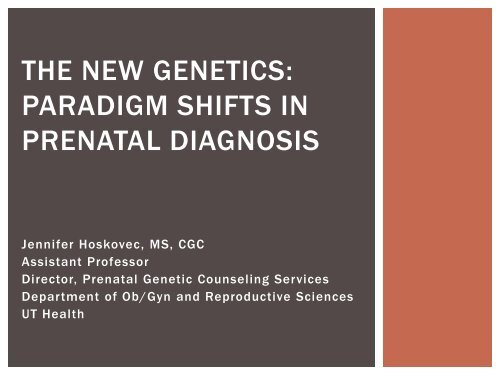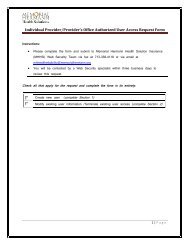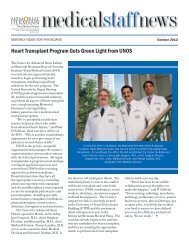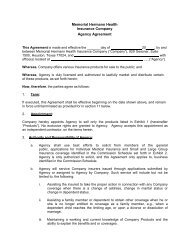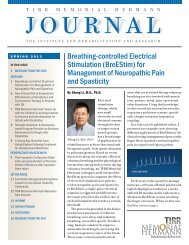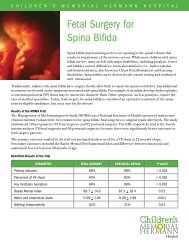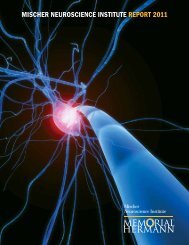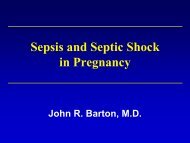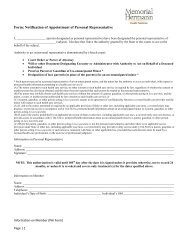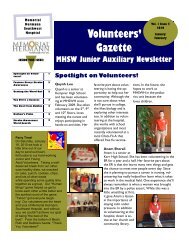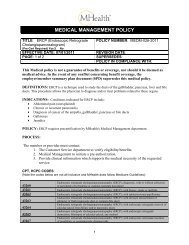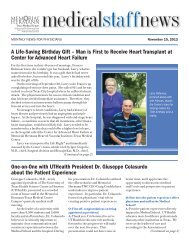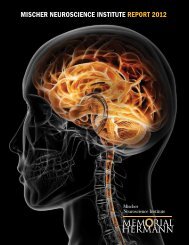The New Genetics: Paradigm Shifts in Prenatal Diagnosis
The New Genetics: Paradigm Shifts in Prenatal Diagnosis
The New Genetics: Paradigm Shifts in Prenatal Diagnosis
You also want an ePaper? Increase the reach of your titles
YUMPU automatically turns print PDFs into web optimized ePapers that Google loves.
THE NEW GENETICS:<br />
PARADIGM SHIFTS IN<br />
PRENATAL DIAGNOSIS<br />
Jennifer Hoskovec, MS, CGC<br />
Assistant Professor<br />
Director, <strong>Prenatal</strong> Genetic Counsel<strong>in</strong>g Services<br />
Department of Ob/Gyn and Reproductive Sciences<br />
UT Health
OUTLINE<br />
• Overview of standard screen<strong>in</strong>g and test<strong>in</strong>g options for<br />
aneuploidy<br />
• Non-Invasive <strong>Prenatal</strong> Test<strong>in</strong>g for aneuploidy (NIPT)<br />
• Chromosomal Microarray Analysis <strong>in</strong> the prenatal sett<strong>in</strong>g
Standard Screen<strong>in</strong>g and Test<strong>in</strong>g Options for<br />
Invasive <strong>Prenatal</strong><br />
Screen<strong>in</strong>g Fetal Aneuploidy <strong>Diagnosis</strong><br />
• Screen<strong>in</strong>g Options:<br />
• First Trimester Screen<strong>in</strong>g<br />
• Quadruple Marker Screen<br />
• Integrated, Sequential, or<br />
Cont<strong>in</strong>gency Screens<br />
• Anatomy Scan<br />
• Benefit(s)<br />
• Non-<strong>in</strong>vasive = no risk<br />
• Identifies women from low<br />
risk pool who are at<br />
<strong>in</strong>creased risk<br />
• Disadvantage(s)<br />
• Risk calculation only<br />
• False positive/negative<br />
• Limited to trisomy 18, 13,<br />
21<br />
• Tim<strong>in</strong>g, <strong>in</strong>surance coverage<br />
• Patient anxiety<br />
• Test<strong>in</strong>g Options:<br />
• Chorionic Villus<br />
Sampl<strong>in</strong>g (CVS)<br />
• Amniocentesis<br />
• Benefit(s)<br />
• Diagnostic <strong>in</strong>formation<br />
on all aneuploidies<br />
• Additional test<strong>in</strong>g<br />
available such as<br />
microarray, PCR<br />
• Disadvantage(s)<br />
• Invasive, risk of<br />
pregnancy loss (1/300-<br />
1/500)
NON-INVASIVE<br />
PRENATAL<br />
NIPT<br />
TESTING
NIPT<br />
• Available cl<strong>in</strong>ically s<strong>in</strong>ce November 2011 <strong>in</strong> the United States<br />
• Analyzes cell-free fetal DNA circulat<strong>in</strong>g <strong>in</strong> maternal blood:<br />
(cffDNA)<br />
• Placental and fetal-derived cells<br />
• Possibly through the breakdown of fetal cells <strong>in</strong> circulation<br />
• ~10-15% of cell-free DNA circulat<strong>in</strong>g <strong>in</strong> maternal blood is from<br />
the fetus<br />
• Quantitative differences <strong>in</strong> chromosome fragments can<br />
identify fetuses with Down syndrome, trisomy 18, trisomy 13,<br />
and sex chromosome abnormalies<br />
• Two different techniques<br />
• MPSS<br />
• DANSR + FORTE
MASSIVELY PARALLEL SHOTGUN<br />
SEQUENCING<br />
• Simultaneously sequence millions of short segments from<br />
amplified DNA<br />
• Hundreds of sequences generated <strong>in</strong> a s<strong>in</strong>gle run<br />
• Amplifies maternal and fetal DNA together<br />
• Increases number of samples run<br />
• Decreases cost<br />
• Different platforms used<br />
• Technique currently used by Sequenom and Ver<strong>in</strong>ata
NIPT WITH MPSS<br />
Unaffected<br />
Each diagrammatic fragment<br />
represents many thousands of<br />
sequenced fragments from<br />
chromosome 21.<br />
<strong>The</strong> quantitative overabundance<br />
of Trisomy 21<br />
fragments <strong>in</strong> an affected<br />
pregnancy is significant and can<br />
be measured with high<br />
precision.<br />
Extra Chromosome<br />
Fragments = Affected<br />
Unaffected Fetus Fetus with Trisomy 21<br />
Slide adapted from Sequenom
DANSR + FORTE<br />
• DANSR- Digital Analysis of Selected Regions<br />
• Chromosome selective approach: selectively evaluates specific<br />
genomic fragments from cfDNA<br />
• Determ<strong>in</strong>es fraction of fetal cfDNA <strong>in</strong> maternal plasma as well as the<br />
chromosome proportion by assay<strong>in</strong>g polymorphic and<br />
nonpolymorphic loci<br />
• FORTE- Fetal-fraction Optimized Risk of Trisomy Evaluation<br />
• Algorithm that takes <strong>in</strong>to account additional data: prior risk (based<br />
on maternal age and gestational age) as well as fetal fraction<br />
• Enables determ<strong>in</strong>ation of chromosome proportion and fetal fraction<br />
at same time<br />
• Requires less DNA sequenc<strong>in</strong>g and can analyze ~750 patient<br />
samples per run<br />
• Technique currently used by Ariosa
NIPT VALIDATION STUDIES<br />
• NIPT has been validated by multiple groups:<br />
• In high risk pregnancies<br />
• AMA<br />
• Abnormal serum screen<br />
• Family or personal hx of child with aneuploidy<br />
• Abnormal ultrasound suggestive of aneuploidy<br />
• Between 10-22 weeks gestation
• 25 tw<strong>in</strong> pregnancies<br />
• 17 normal pairs<br />
• 5 with Down syndrome <strong>in</strong> one fetus of tw<strong>in</strong> pair<br />
• 2 with Down syndrome <strong>in</strong> both fetuses of tw<strong>in</strong> pair<br />
• 1 with trisomy 13 <strong>in</strong> one fetus of tw<strong>in</strong> pair<br />
• All pregnancies were correctly classified<br />
• 25/25 confidence <strong>in</strong>terval [59-100]<br />
• Two triplet pregnancies studied<br />
• Unaffected; correctly classified<br />
• Authors note tw<strong>in</strong> pregnancies have higher placental mass<br />
and therefore might have higher fetal fraction and thus better<br />
separation of affected and unaffected fetuses despite the<br />
presence of multiples.
• 2049 pregnant women undergo<strong>in</strong>g rout<strong>in</strong>e screen<strong>in</strong>g at 11 -13<br />
weeks gestation<br />
• 86 pregnancies (4.3%) had karyotype via CVS or amniocentesis<br />
• 1963 pregnancies were phenotypically normal at birth (assumed euploid)<br />
• Harmony risk scores available for 1949 (95.1%) pregnancies<br />
• 46 (2.2%) had low fetal fraction<br />
• 54 (2.6%) had assay failure<br />
• Trisomy 21<br />
• Detected 8/8 cases, all hav<strong>in</strong>g risk scores >99%<br />
• Trisomy 18<br />
• Detected 2/3 cases, both hav<strong>in</strong>g risk scores >99%, the third was an<br />
assay failure<br />
• 1939 euploid pregnancies<br />
• 1937 has risk scores of
RAPID CLINICAL EVOLUTION<br />
• Ver<strong>in</strong>ata<br />
• Report<strong>in</strong>g sex chromosomes (Normal = XX, XY) and identification of<br />
sex chromosome aneuploidies (XXX, XXY, XYY, monosomy X)<br />
• Sequenom<br />
• Report<strong>in</strong>g absence or presence of Y chromosome material on all<br />
patients (99.4% accuracy quoted)
NIPT IN CLINICAL CARE<br />
Three<br />
separate<br />
groups<br />
have now<br />
shown<br />
high<br />
sensitivity<br />
and<br />
specificity<br />
with low<br />
false<br />
positive<br />
rate
NIPT<br />
• Very high specificity and sensitivity<br />
• Detection Rates<br />
• Down syndrome: >99% (0.2% FPR)<br />
• Trisomy 18: 97-100% (≤0.2% FPR)<br />
• Trisomy 13: 79-92% (1.0% FPR)<br />
* Detection rates and FPR vary slightly between labs<br />
• Results<br />
• Typically reported as “positive” or “negative”<br />
• Some labs dist<strong>in</strong>guish between results close to or distant from<br />
the cut-off<br />
• Results close to the cut-off would have less confidence<br />
• Some labs classify those results as “unclassifiable,” some<br />
would place results on a cont<strong>in</strong>uum scale<br />
• Confirmatory test<strong>in</strong>g via CVS or amniocentesis is<br />
recommended for positive results
INCORPORATION INTO CLINICAL<br />
CARE<br />
Assume 100,000 women at high risk<br />
» 1:32 of affected:unaffected<br />
» Diagnostic test<strong>in</strong>g cost of $1000/patient<br />
» Procedure loss rate of 1/200<br />
Complete uptake of<br />
diagnostic test<strong>in</strong>g:<br />
Detects 3000 cases<br />
Cost of $100 million<br />
500 procedure-related<br />
losses<br />
Complete uptake of MPSS<br />
followed by diagnostic test<strong>in</strong>g<br />
for positive results:<br />
» Detect 2958 cases (miss 42)<br />
» Cost of $3.9 million<br />
» 20 procedure-related losses<br />
Palomaki GE et al. Genet Med 2011
NIPT: LIMITATIONS<br />
• Current limitations<br />
• Validation<br />
• Limited validation studies <strong>in</strong> low risk women<br />
• Validation study <strong>in</strong> tw<strong>in</strong>s had only 25 sets<br />
• Not validated <strong>in</strong> triplet or higher order multiples<br />
• Not validated <strong>in</strong> pregnancies conceived with egg donors<br />
• Not validated past 22 weeks gestation<br />
• Cost and <strong>in</strong>surance coverage<br />
• Does not <strong>in</strong>clude screen<strong>in</strong>g for ONTD
NIPT Specifics<br />
Laboratory<br />
(Test name)<br />
Technology<br />
Conditions<br />
Tested For<br />
Sensitivity Specificity Report<strong>in</strong>g<br />
Sequenom<br />
(MaterniT21Plus)<br />
MPSS Trisomy 21<br />
Trisomy 18<br />
Trisomy 13<br />
T21 = 99.1%<br />
T18 = >99.9%<br />
T13 = 91.7%<br />
T21 = 99.9%<br />
T18 = 99.6%<br />
T13 = 99.7%<br />
Positive<br />
Negative<br />
Failure<br />
Ver<strong>in</strong>ata<br />
(Verify)<br />
MPSS Trisomy 21<br />
Trisomy 18<br />
Trisomy 13<br />
Sex<br />
Chromosomes<br />
T21 = 100%<br />
T18 = 97.2%<br />
T13 = 78.6%<br />
45X = 95%<br />
XXX, XXY, XYY =<br />
Limited data<br />
T21 = 100%<br />
T18 = 100%<br />
T13 = 100%<br />
45X = 100%<br />
Positive<br />
Negative<br />
Aneuploidy<br />
suspected<br />
Failure<br />
Ariosa<br />
(Harmony)<br />
Partnered with<br />
Integrated<br />
<strong>Genetics</strong><br />
(LabCorp)<br />
DANSR<br />
(assay)<br />
+<br />
FORTE<br />
(algorithm)<br />
Trisomy 21<br />
Trisomy 18<br />
Trisomy 13<br />
T21 = 100%<br />
T18 = 97.4%<br />
T21 = 99.9%<br />
T18 = 99.9%<br />
Risk Ratio via<br />
algorithm<br />
1/10,000 –<br />
99/100<br />
(0.5% results fell<br />
between the two<br />
extreme values)
NONINVASIVE PRENATAL TESTING/NONINVASIVE PRENATAL DIAGNOSIS<br />
(NIPT/NIPD): <strong>The</strong> National Society of Genetic Counselors currently supports<br />
Non<strong>in</strong>vasive <strong>Prenatal</strong> Test<strong>in</strong>g/Non<strong>in</strong>vasive <strong>Prenatal</strong> <strong>Diagnosis</strong> (NIPT/NIPD) as<br />
an option for patients whose pregnancies are considered to be at an<br />
<strong>in</strong>creased risk for certa<strong>in</strong> chromosome abnormalities. NSGC urges that<br />
NIPT/NIPD only be offered <strong>in</strong> the context of <strong>in</strong>formed consent, education, and<br />
counsel<strong>in</strong>g by a qualified provider, such as a certified genetic counselor.<br />
Patients whose NIPT/NIPD results are abnormal, or who have other factors<br />
suggestive of a chromosome abnormality, should receive genetic counsel<strong>in</strong>g<br />
and be given the option of standard confirmatory diagnostic test<strong>in</strong>g. (Adopted<br />
February 18, 2012)
ACOG/SMFM COMMITTEE OPINION<br />
NUMBER 545 DECEMBER 2012<br />
• Non<strong>in</strong>vasive <strong>Prenatal</strong> Test<strong>in</strong>g for Fetal Aneuploidy<br />
• ABSTRACT: Non<strong>in</strong>vasive prenatal test<strong>in</strong>g that uses cell free<br />
fetal DNA from the plasma of pregnant women offers<br />
tremendous potential as a screen<strong>in</strong>g tool for fetal aneuploidy.<br />
Cell free fetal DNA test<strong>in</strong>g should be an <strong>in</strong>formed patient<br />
choice after pretest counsel<strong>in</strong>g and should not be part of<br />
rout<strong>in</strong>e prenatal laboratory assessment. Cell free fetal DNA<br />
test<strong>in</strong>g should not be offered to low -risk women or women<br />
with multiple gestations because it has not been sufficiently<br />
evaluated <strong>in</strong> these groups. A negative cell free fetal DNA test<br />
result does not ensure an unaffected pregnancy. A patient<br />
with a positive test result should be referred for genetic<br />
counsel<strong>in</strong>g and should be offered <strong>in</strong>vasive prenatal diagnosis<br />
for confirmation of test results.
NIPT FUTURE DIRECTIONS<br />
• Additional validation studies on use <strong>in</strong> low -risk<br />
population and multiple gestations<br />
• Other chromosomal disorders and<br />
microdeletions/duplications<br />
• Use for Mendelian disorders<br />
• <strong>New</strong> technology may <strong>in</strong>crease accuracy<br />
• MeDiP: enriches for fetal-specific hypermethylated DNA<br />
regions<br />
• Whole genome sequenc<strong>in</strong>g<br />
• With<strong>in</strong> the next 10 years, the complete fetal genome<br />
will be successfully sequenced from maternal plasma<br />
Lo (Prenat Diagn 2010;30:702-3)
SUMMARY<br />
• So many options!<br />
• Accurate and balanced discussion of options with patient is very<br />
important<br />
• Benefits<br />
• Limitations<br />
• Risks<br />
• Assist the patient <strong>in</strong> mak<strong>in</strong>g <strong>in</strong>formed, autonomous decision<br />
• Be sensitive to personal nature of decision<br />
• Family values<br />
• Religious beliefs<br />
• Family and life situations<br />
• Concerns about hav<strong>in</strong>g a child with an abnormality<br />
• Concerns about risk of miscarriage
PRENATAL DIAGNOSTIC TESTING<br />
• CVS and amniocentesis<br />
• Rout<strong>in</strong>e karyotype<br />
• FISH<br />
• Aneuploidy FISH (13, 18, 21, X, Y)<br />
• Site specific FISH for deletion syndromes (22q11.2)<br />
• Chromosomal Microarray Analysis
CHROMOSOMAL MICROARRAY ANALYSIS<br />
• CMA platforms use thousands of DNA probes spread across the<br />
genome to detect ga<strong>in</strong>s and losses of genetic material.<br />
• Extracted DNA from the patient (fetus) is compared with a<br />
reference (normal) genome.<br />
• Allows identification of abnormal copy number changes (ga<strong>in</strong>s<br />
and losses).<br />
• Aneuploidy<br />
• Duplications and deletions – too small to be seen by conventional<br />
cytogenetics<br />
• Limitations:<br />
• Cannot detect balanced chromosome rearrangements (identifies dosage<br />
differences, not positional differences)<br />
• Cannot identify triploidy<br />
• Possible Pitfalls:<br />
• Identification of a copy variant of unknown significance (~1.5%)<br />
• Requires parental bloods for comparison<br />
• Possible out of pocket expense to the patient
Overview of CMA Process<br />
1<br />
Patient<br />
Control<br />
Hybridization<br />
to Array<br />
Mix<br />
CMA<br />
Methodology<br />
Laser Scanner<br />
2 3<br />
Data analysis<br />
FISH confirmation<br />
del 22:q11.21
EXAMPLE- NORMAL RESULTS
EXAMPLE- TRISOMY 21
CHROMOSOMAL MICROARRAY ANALYSIS<br />
IN PRENATAL CLINICAL PRACTICE<br />
• Each <strong>in</strong>dividual syndrome <strong>in</strong>cidence low<br />
• Ex: 22q11.2 deletion syndrome, AKA DiGeorge syndrome (22q11.2 del;<br />
>95% detection; 1 <strong>in</strong> 4000-6000 <strong>in</strong>cidence)<br />
• Ex: Williams Syndrome (7q11 del; 95% detection; 1 <strong>in</strong> 10,000 <strong>in</strong>cidence)<br />
• Ex: Prader Willi Syndrome (15q11 del; 70% detection; 1 <strong>in</strong> 25,000<br />
<strong>in</strong>cidence)<br />
• Detailed detection potential for CMA version 6.3 oligo at BCM:<br />
http://www.bcm.edu/geneticlabs/<strong>in</strong>dex.cfmpmid=16202<br />
• Likelihood of f<strong>in</strong>d<strong>in</strong>g a cl<strong>in</strong>ically relevant <strong>in</strong>formation not<br />
identified on rout<strong>in</strong>e karyotype ( N ENGL J MED 367;23 Dec 6, 2012)<br />
• 1.7% of women referred for rout<strong>in</strong>e <strong>in</strong>dications (AMA, pos screen, etc)<br />
with normal ultrasound and karyotype had a cl<strong>in</strong>ically significant f<strong>in</strong>d<strong>in</strong>g<br />
on CMA<br />
• 6% of women with abnormal ultrasound f<strong>in</strong>d<strong>in</strong>gs and normal karyotype<br />
had a cl<strong>in</strong>ically significant f<strong>in</strong>d<strong>in</strong>g on CMA
QUESTIONS
REFERENCES<br />
Lo et al (1997) Presence of fetal DNA <strong>in</strong> maternal plasma and serum.<br />
Lancet<br />
F<strong>in</strong>n<strong>in</strong>g et al (2002) Prediction of fetal D status from maternal plasma:<br />
<strong>in</strong>troduction of a new non<strong>in</strong>vasive fetal RHD genotyp<strong>in</strong>g service.<br />
Transfusion<br />
Bianchi DW (2004) Circulat<strong>in</strong>g fetal DNA: its orig<strong>in</strong> and diagnostic<br />
potential- a review.<br />
D<strong>in</strong>g et al (2004) MS analysis of s<strong>in</strong>gle-nucleotide differences <strong>in</strong><br />
circulat<strong>in</strong>g nucleic acids: application to non -<strong>in</strong>vasive prenatal<br />
diagnosis. PNAS<br />
Gautier et al (2005) Fetal RhD genotyp<strong>in</strong>g by maternal serum analysis:<br />
a two-year experience. AJOG<br />
Scheffer et al (2011) Non<strong>in</strong>vasive fetal blood group genotyp<strong>in</strong>g if rhesus D,<br />
c, E, and of K <strong>in</strong> alloimmunised pregnant women: evaluation of a 7-year<br />
cl<strong>in</strong>ical experience. BJOG<br />
<br />
Chiu et al (2011), Non-<strong>in</strong>vasive prenatal assessment of trisomy 21 by<br />
multiplexed maternal plasma DNA sequenc<strong>in</strong>g: large scale validity study.<br />
BMJ
REFERENCES<br />
<br />
Palomaki et al (2011), DNA sequenc<strong>in</strong>g of maternal plasma to detect Down<br />
syndrome: an <strong>in</strong>ternational cl<strong>in</strong>ical validation study. <strong>Genetics</strong> <strong>in</strong> Medic<strong>in</strong>e<br />
<br />
Palomaki et al (2012), DNA sequenc<strong>in</strong>g of maternal plasma reliably identifies<br />
trisomy 18 and trisomy 13 as well as Down syndrome: an <strong>in</strong>ternational collaborative<br />
study. <strong>Genetics</strong> <strong>in</strong> Medic<strong>in</strong>e<br />
Bianchi et al (2012) Genome-wide fetal aneuploidy detection by maternal<br />
plasma DNA sequenc<strong>in</strong>g. Obstetrics and Gynecology<br />
Sparks et al (2012) Non-<strong>in</strong>vasive prenatal detection and selective analysis of<br />
cell-free DNA obta<strong>in</strong>ed from maternal blood: evaluation for trisomy 21 and<br />
trisomy 18. AJOG<br />
Ashoor et al (2012) Chromosome-selective sequenc<strong>in</strong>g of maternal plasma cell -<br />
free DNA for first-trimester detection of trisomy 21 and trisomy 18. AJOG<br />
Colah et al (2011) Invasive and non-<strong>in</strong>vasive approaches for prenatal diagnosis<br />
of haemoglob<strong>in</strong>opathies: experiences from India. Indian J Med Res<br />
Norton et al (2012) Non Invasive Chromosomal Evaluation (NICE) Study: results<br />
of a multicenter prospective cohort study for detection of fetal trisomy 21 and<br />
trisomy 18. AJOG.<br />
Canick et al (2012) DNA sequenc<strong>in</strong>g of maternal plasma to identify Down<br />
syndrome and other trisomies <strong>in</strong> multiple gestations. Prenat <strong>Diagnosis</strong>
REFERENCES<br />
• Benn et al (2011) <strong>Prenatal</strong> detection of Down syndrome us<strong>in</strong>g massively parallel<br />
shotgun sequenc<strong>in</strong>g : a rapid response position statement from a committee on<br />
behalf of the board of the <strong>in</strong>ternational society for prenatal diagnosis.<br />
• NSGC (2012) Position statement on non<strong>in</strong>vasive prenatal test<strong>in</strong>g/non<strong>in</strong>vasive<br />
prenatal diagnosis.<br />
• Sehnert et al (2011) Optimal detection of fetal chromosomal abnormalities by<br />
massively parallel DNA sequenc<strong>in</strong>g of cell -free fetal DNA from maternal blood.<br />
Cl<strong>in</strong>ical Chemistry<br />
• Ladha, S (2012) A new era of non-<strong>in</strong>vasive prenatal genetic diagnosis: exploit<strong>in</strong>g<br />
fetal epigenetic differences. Cl<strong>in</strong> Genet<br />
Devaney et al (2011) Non<strong>in</strong>vasive fetal sex determ<strong>in</strong>ation us<strong>in</strong>g cell -free fetal<br />
DNA: a systematic review and meta -analysis. JAMA<br />
Hill et al (2011) Non-<strong>in</strong>vasive prenatal determ<strong>in</strong>ation of fetal sex: translat<strong>in</strong>g<br />
research <strong>in</strong>to cl<strong>in</strong>ical practice. Cl<strong>in</strong> Genet<br />
Geifman-Holtzman et al (2006) Diagnostic accuracy of non<strong>in</strong>vasive fetal Rh<br />
genotyp<strong>in</strong>g from maternal blood- a meta-analysis. AJOG<br />
Lo, Y (1994) Non-<strong>in</strong>vasive prenatal diagnosis us<strong>in</strong>g fetal cells <strong>in</strong> maternal blood. J<br />
Cl<strong>in</strong> Pathol<br />
Benn et al (2012) Non-<strong>in</strong>vasive prenatal diagnosis for Down syndrome: the<br />
paradigm will shift, but slowly. Ultrasound Obstet Gynecol
REFERENCES<br />
• Nicolaides et al (2012) Non<strong>in</strong>vasive prenatal test<strong>in</strong>g for fetal trisomies <strong>in</strong> a<br />
rout<strong>in</strong>ely screened first-trimester population. AJOG<br />
• Wapner et al (212) Chromosomal Microarray versus Karyotyp<strong>in</strong>g for <strong>Prenatal</strong><br />
<strong>Diagnosis</strong>. NEJM


